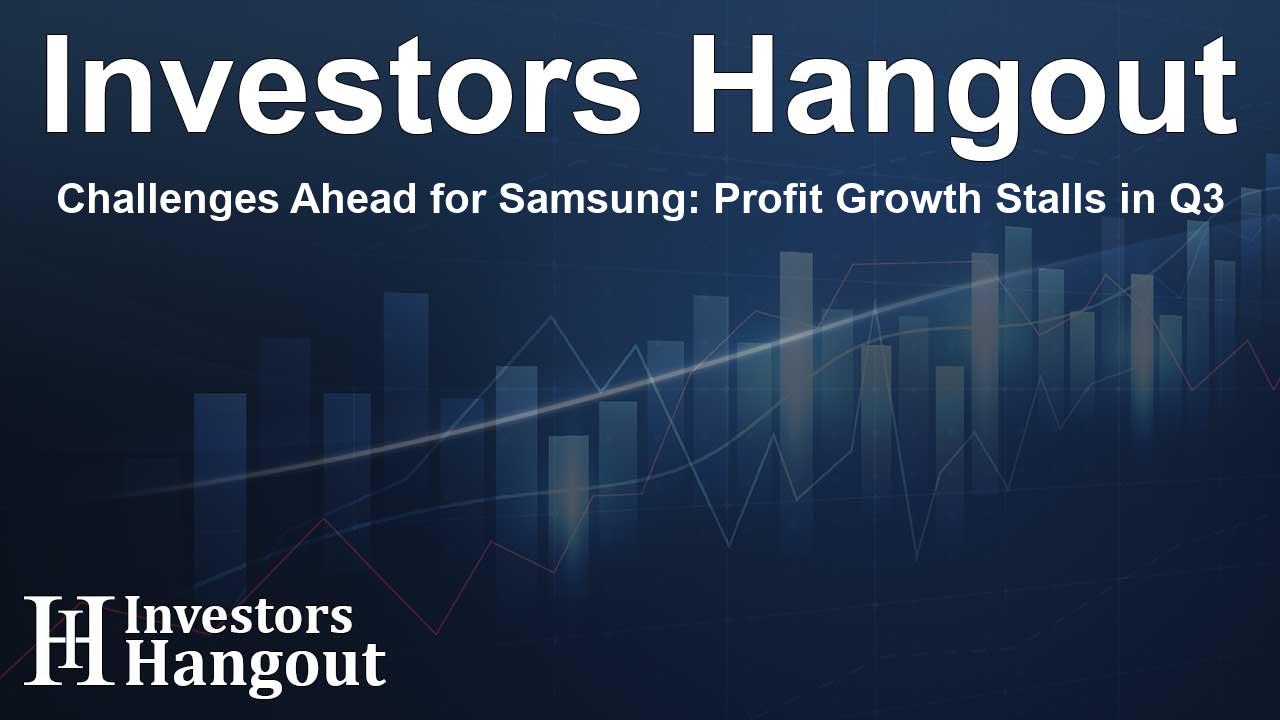Challenges Ahead for Samsung: Profit Growth Stalls in Q3

Samsung's Profit Recovery Faces Significant Challenges
Samsung Electronics (KS: 005930) is anticipated to announce a notable increase in its quarterly profits, with projections indicating a four-fold leap due to an uptick in chip demand. However, there are concerns regarding the speed of this recovery as the company struggles to enhance its presence in the booming artificial intelligence sector.
Quarterly Profit Expected to Soar
The world's leading manufacturer of memory chips, smartphones, and televisions, Samsung is expected to report an operating profit of around 10.33 trillion won (approximately $7.67 billion) for the quarter ending on September 30. This marks a substantial increase from last year’s 2.43 trillion won; however, it represents a slight decrease from the previous quarter's 10.44 trillion won.
The Semiconductor Market Recovery
The global semiconductor industry is on the mend after experiencing a downturn the prior year, primarily driven by demand for chips utilized in AI servers. Unfortunately, the recovery in demand for conventional chips, especially those employed in smartphones and PCs, is lagging, according to analysts.
Competition and Market Pressures
As Samsung grapples with its recovery, the company finds itself in a tight race against SK Hynix and Micron (NASDAQ: MU) to deliver high-end AI chips to tech giants like Nvidia (NASDAQ: NVDA). Additionally, Samsung is facing increased competition from Chinese manufacturers within the commodity chip market, which has further complicated their growth strategy.
Expected Operating Profit in Chip Division
Samsung’s chip division is projected to shift to an operational profit of 5.5 trillion won compared to the previous year. However, this reflects a 15% decline from the prior quarter, influenced by the company's decision to allocate additional funds for employee bonuses.
Geopolitical and Market Risks
Analysts suggest that Samsung’s slower response to capitalizing on the lucrative AI chip market, combined with its higher exposure to traditional mobile chips and geopolitical uncertainties, places the company at a disadvantage compared to its rivals. The potential loss of its leading position in the DRAM sector could become a reality if the commodity DRAM market softens, according to Daniel Kim from Macquarie Equity Research.
Micron's Strong Performance
In contrast to Samsung's challenges, Micron recently reported stronger-than-expected first-quarter results, showcasing the highest quarterly revenue it has seen in over ten years, fueled by increased demand for memory chips used in the AI sector.
Struggles in Non-Memory Chip Operations
Samsung’s efforts in the non-memory chip segment, including chip design and contract manufacturing, continue to face hurdles, with losses expected in the third quarter as the company struggles to rival TSMC, a leader in this field, who counts major firms like Apple (NASDAQ: AAPL) and Nvidia among its customers.
Workforce Reductions and Market Challenges
The challenges facing the South Korean firm are evident as reports indicated plans to cut up to 30% of its overseas workforce in certain divisions. Furthermore, the sales figures for Samsung's premium foldable phones have underperformed expectations, which is anticipated to further affect overall profit amid stiff competition from Chinese brands like Huawei.
Outlook for Samsung Electronics
The operating profit for Samsung's mobile phone and network businesses fell significantly, with estimates suggesting an operating profit drop to 2.6 trillion won, down one-fifth from the prior year. This decline reinforces the competitive pressures the company faces.
With shares of Samsung Electronics having declined by 23% this year, the company finds itself trailing behind SK Hynix, which has seen a similar rise this year. As the firm prepares to release its preliminary earnings for the third quarter, analysts and investors alike remain vigilant in monitoring developments in the semiconductor landscape.
Frequently Asked Questions
What is Samsung Electronics' expected quarterly profit?
Samsung is projected to report an operating profit of 10.33 trillion won for the most recent quarter.
What factors are impacting Samsung's profit recovery?
The slowing demand for conventional chips and increased competition in the AI chip market are key factors impeding profit recovery.
How is Samsung's chip division performing?
Samsung's chip division is expected to report a profit, although this represents a decrease from the previous quarter's figures.
What challenges does Samsung face in the market?
Samsung faces competition from SK Hynix, Micron, and Chinese manufacturers, affecting its profitability and market position.
When will Samsung announce its earnings?
Samsung is set to announce its preliminary third-quarter earnings shortly, with full results expected later this month.
About The Author
Contact Evelyn Baker privately here. Or send an email with ATTN: Evelyn Baker as the subject to contact@investorshangout.com.
About Investors Hangout
Investors Hangout is a leading online stock forum for financial discussion and learning, offering a wide range of free tools and resources. It draws in traders of all levels, who exchange market knowledge, investigate trading tactics, and keep an eye on industry developments in real time. Featuring financial articles, stock message boards, quotes, charts, company profiles, and live news updates. Through cooperative learning and a wealth of informational resources, it helps users from novices creating their first portfolios to experts honing their techniques. Join Investors Hangout today: https://investorshangout.com/
The content of this article is based on factual, publicly available information and does not represent legal, financial, or investment advice. Investors Hangout does not offer financial advice, and the author is not a licensed financial advisor. Consult a qualified advisor before making any financial or investment decisions based on this article. This article should not be considered advice to purchase, sell, or hold any securities or other investments. If any of the material provided here is inaccurate, please contact us for corrections.
